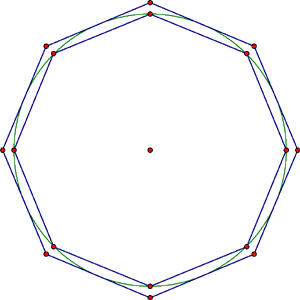
Calculating Pi
home | courses | topics | theorems | starters | worksheets | timeline | KS3 | KS4 | KS5
Archimedes was one of those people who wanted to know the exact value of Pi. So at some point he must have thought something on the lines of: "How do you calculate it?" In Ancient Greek that is. So he started looking at perimeter of polygons inscribed in a circle; he calculated the area of a regular polygon with a circle inscribed in it, then the area of a regular polygon inscribed in a circle itself. It looked something like this:

He then calculated the perimeter of the inscribed and circumscribed polygon - the middle value would be an approximation of the circumference of the circle. Archimedes thought of Pi as a ratio between circumference and diameter or radius of the circle. He actually used 96-sided polygons as in the example above and got the value of Pi to be between 310/71 and 310/70.
Click above to activate applet for estimating Pi Archimedes' way.
(If you can't see the picture above, that means that your browser does not support Java.)
Click on the picture of Archimedes to learn more about him.
He lived and died in Syracusa in Italy - click here to see it and to see some other famous places where famous mathematics was done.

There is a whole lot of things to be learnt about Pi - click here.
Want to play with circles? Click here to learn more about them.
artefacts | numerals | concepts | people | places | pythagoreans | egyptians | babylonians
_____________________________________________________________________________________________________________________
Acknowledgements | Copyright | Contact | Mission Statement | Tell a friend about this site
